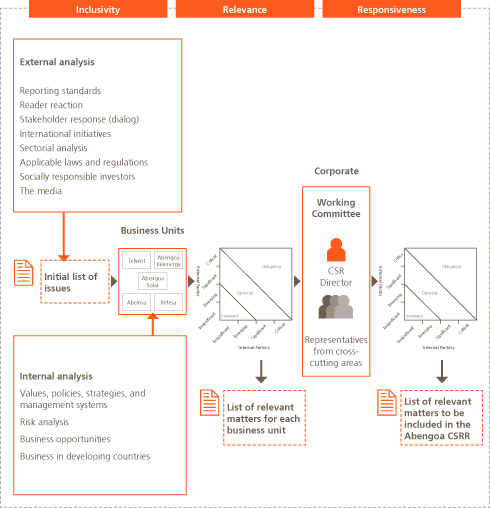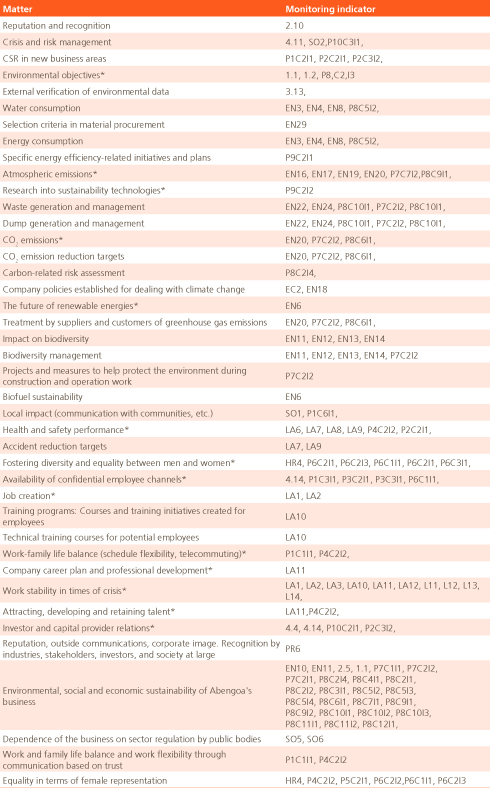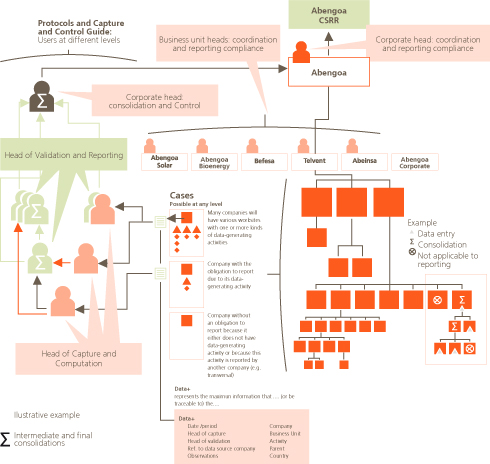 Abengoa
Abengoa
Annual Report 2010
- Corporate Social Responsibility Report
- Report Preparation Process
- Principles Governing Report Preparation
Principles Governing Report Preparation
Abengoa’s approach to determining relevant issues is to apply the three principles defined under the AA1000 AS Standard (2008): inclusivity, relevance, and responsiveness; as well as the four GRI principles: materiality, stakeholder inclusiveness, sustainability context, and completeness. These principles are intertwined, and from among them the principle of materiality has been chosen to underpin the three other principles.
GRI-based Principles for Determining Report Content
Materiality
Information is considered material if the omission or distortion thereof may have an effect on the decisions or actions of the stakeholders of the reporting organization. Materiality therefore refers to the relevance for the business of the different aspects related to sustainability.
Accordingly, the information contained in the CSRR 2010 covers aspects and indicators that reflect the company’s significant social, environmental and economic impacts or those which may have substantial influence on stakeholder evaluations and decisions.
In 2010, Abengoa conducted an analysis of materiality through a procedure for determining relevant CSR matters centered on two bases for analysis that subsequently intersect to obtain the final result. These two bases for analysis are external factors (those related to the expectations of Abengoa’s stakeholders and the importance the latter attach to the different matters) and internal factors (which determine the significance of different issues for the business, company management, and, ultimately, in fulfilling business strategy). Employing both perspectives is essential to upholding the principle of inclusivity defined under the AA1000 AS Standard (2008).
The following sources were taken into account in preparing the list of external factors:
- International reporting standards, consisting primarily of the GRI and AA1000 AS (2008).
- Sector analysis, benchmarking, and analysis of the main national and international homologous and competing companies to identify those that may be considered CSR leaders with the aim of determining the main challenges for the relevant sectors in the different chapters of the CSRR.
- The DJSI and the FTSE4Good, which track the most important issues for socially responsible stakeholders, thereby helping to anticipate future challenges.
- International initiatives, including the United Nations Global Compact and Caring for Climate. These and other voluntary agreements embrace of a series of principles that demand certain commitments from the company, which are evaluated on an annual basis and enable the company to identify new material issues.
- Analysis of reader response to last year’s report submitted through the communication channels made available for this purpose.
- Periodic review of prevailing legislation.
- The media; through an analysis of Abengoa’s exposure in both the media and communications of homologous and competing companies, the company has identified those positive and negative CSR-related matters that received the most media coverage.
To select internal factors, a committee was set up, composed of thirteen employees from representative company areas and presided over by the head of Corporate Social Responsibility. The committee, by secret ballot, selected a number of internal issues (related to company values, policies, strategies and also staff concerns) and analyzed the degree of materiality of each issue, along with the materiality of the external factors and the relevant issues extracted from analogous procedures conducted in the Abengoa business units. A prioritized list was then drawn up after taking into account the nature and dimension of each aspect analyzed.

* Esquema del Procedimiento de Asuntos Relevantes de RSC de Abengoa.
Asuntos relevantes de RSC - Resultados 2010

All relevant issues tagged as critical have been added to the contents of this report and are indicated in the text with the ® symbol. These matters will be followed up on by the committee and monitored by company management.
Stakeholder Inclusiveness
This principle dictates that the reporting organization show in its report the measures implemented in response to stakeholder concerns and interests.
Abengoa, during the process of preparing and developing its executive CSR plan, identified approximately one hundred key stakeholder opinion leaders with the purpose of finding out their expectations and perceptions. Stakeholder consultation is aimed at ascertaining the importance of the challenges identified, the perception of Abengoa’s performance with respect to each issue, and the current status of those issues tagged as significant.
Furthermore, to complement the analysis of CSR-related relevant issues, Abengoa is presently immersed in a process of consulting experts from top-tier organizations in order to delve deeper into those issues related to Corporate Social Responsibility tagged as material for the company. Through this process, Abengoa seeks to gain first-hand knowledge of the challenges and trends characterizing the key issues identified, in addition to external, independent and acknowledged perception of the company’s performance in managing these issues.
For the third consecutive year, Abengoa has undergone an evaluation by an Independent Panel of Experts on Sustainable Development (IPESD), up of independent made professionals of international renown in the environmental, social and economic spheres.
This panel voices the perspectives and opinions of Abengoa’s stakeholders in order to make sure that the company is reporting information related to the issues they find relevant, while providing recommendations on how the company should address these matters. To this end, the members of the panel conducted an analytical review of the CSRR published by Abengoa in 2009 with the aim of fostering information transparency by participating in an open dialogue between the company and its stakeholders, and by issuing their evaluation of the materiality of the company’s CSRR and the solutions provided to its stakeholders. The responses provided by Abengoa to the questions formulated by the IPESD were verified externally and obtained a reasonable level of assurance.
The members of the IPESD are Antonio Vives, Charles Donovan, Francesca Broadbent, Jermyn Brooks, Matthew Bateson, and Sol Iglesias.
All are independent experts of considerable renown and with proven track records in sustainable development, whose aim is to reflect the views and concerns of society in the report.
Sustainability Context
The reporting organization should present its performance within the broadest context of sustainability. Information on performance should be put into context. The question underlying sustainability reporting is the way in which the organization contributes, or plans to contribute in the future, to the improvement or deterioration of economic, environmental and social trends, developments, and conditions at the local, regional, or global level.
Abengoa is an international company that applies innovative technological solutions for sustainable development, and, throughout the report, evaluates company performance within the context of its contribution to its stakeholders, to the communities where it has a presence, and to the environment.
Abengoa has been a very active company in terms of communicating and propagating initiatives associated with sustainability. In 2010, seminars were organized around themes such as climate change, sustainability and renewable energies; forums for heightening social awareness were promoted, such as the Focus-Abengoa Forum on Energy and Climate Change; numerous articles were published internally and externally on these subjects. These were distributed to different company stakeholders and also included on the website. The contents are based on the cornerstones of the company’s business model: Environmental sustainability, social responsibility, and transparency and rigor in management. The company also features a corporate blog consisting of opinion articles through which to share the company’s views on a host of matters related to sustainability with the rest of the community. This blog, accessible through the corporate website (blog.abengoa.com), is open to comments from any reader with the aim of encouraging dialogue with all stakeholders.
Completeness
Completeness refers to suitable coverage of the indicators and material aspects, in order for them to reflect significant social, economic and environmental impacts and enable stakeholders to assess the performance of the reporting organization during the period covered by the report.
The aim of the report is to reflect, in sufficient detail, the intrinsic implications, risks and challenges associated with each line of the company’s business, making information accessible to a wide-ranging and heterogeneous audience. The document gives greater priority to certain aspects, in accordance with the materiality matrix drawn up from the analysis of relevant issues, and is complemented by case studies and specific examples. For ease in understanding the text and finding information, and with a view to standardizing the way it is presented, a common structure was devised for all chapters and sections of the report.
Indicator coverage, embracing all entities whose performance is described in the report, extends to all Abengoa subsidiaries, including joint ventures, operating on the five continents, provided Abengoa has effective control of their management. Appendix A lists those companies included within the report scope. Any additional exclusions will be specified accordingly in the indicator itself.
Principles Regarding the Quality of the Information Disclosed in Accordance with the GRI
EIn preparing this report, every effort has been made to disclose information in line with the quality standards laid down by the GRI.
Balance
The report should reflect positive and negative aspects to enable a reasonable assessment of company performance.
The 2010 report provides data on positive and improvable aspects of performance, as well as challenges facing the company. The process of identifying material issues (see section on materiality) also contributes to compliance therewith. In addition, the incorporation of the opinions and questions of the Independent Panel of Experts on Sustainable Development, along with the corresponding answers, allows the reader to gain an understanding of the perception of company performance held by society at large.
Comparability
The report should enable readers to analyze performance and change, and therefore includes a comparison with the last reporting period and also indicates any changes in computation methods.
Accuracy
The report should be sufficiently accurate and detailed to be able to evaluate the performance of the reporting organization.
The objective was to be accountable at the highest level of application, A+, and where appropriate, provide an explanation when certain indicators do not apply, are not available or when they refer only to parts of the company.
The verification process to which this report was submitted ensures the accuracy of quantitative data and provides proof and appropriate context for the qualitative information.
Timeliness
The report must be published on time according to a regular schedule so that stakeholders may make decisions based on the right information.
Abengoa has been publishing its Corporate Social Responsibility Report annually since 2004. These reports are available from the company’s website (www.abengoa.com).
Clarity
The information should be presented in a way that is understandable and accessible.
Abengoa publishes a digital edition of the report, which the public can access through the corporate website: annualreport.abengoa.com. The company also distributes the report to its shareholders, key customers, the media, responsible investment institutions, and to any other interested parties.
The CSRR was prepared with due regard to the recommendations from stakeholders on presentation of information. This report also includes a glossary of technical terms and terms that readers may be less familiar with.
Reliability
The information and procedures followed in preparing a report must be gathered, recorded, compiled, analyzed and presented such that it can be subsequently examined and the quality and materiality of the information included in the report determined.
The following chart explains the procedure for consolidating information:

In line with its commitment to transparency, Abengoa required independent third-party verification of the economic, social and environmental information contained in this report. The scope, work description and conclusions of this verification are found in the appendix titled
Report Verification.
Principles of the AA1000APS Standard (2008)
The principles established under the AA1000APS Accountability Standard (2008) require that the organization be actively involved with its stakeholders, identifying and fully understanding the sustainability aspects that will have an impact on performance, before then using this knowledge to develop responsible business strategies and performance objectives. These principles therefore enable the organization to focus on what is relevant, providing a framework for determining and responding to opportunities, in addition to undertaking risk management and compliance with non-financial aspects.
The three principles of the AA1000APS Standard (2008) are as follows:
Inclusivity
The basic principle of inclusivity refers to stakeholder participation in developing and achieving a responsible and strategic response to sustainability. Inclusivity requires a defined process of involvement and participation, which gives rise to strategies, plans and actions that address issues, needs and expectations from the perspective of responsibility3.
Materiality
The principle of materiality involves determining the significance and importance of an issue for the organization and its stakeholders. This demands that a process be in place to incorporate and subsequently analyze the information in a thorough and balanced manner4.
Responsiveness
This reflects the way in which an organization responds to its stakeholders and upholds its responsibility to them. This translates into establishing policies, goals and objectives and action plans, and measuring and monitoring performance or assurance5.
_____________
3 See chapter titled Committed to CSR/Stakeholder Dialog
4 See procedure for analyzing relevant CSR issues described above
5 See chapter titled Committed to CSR